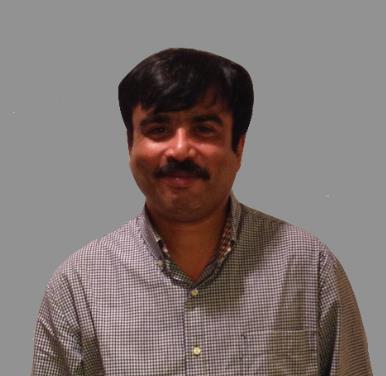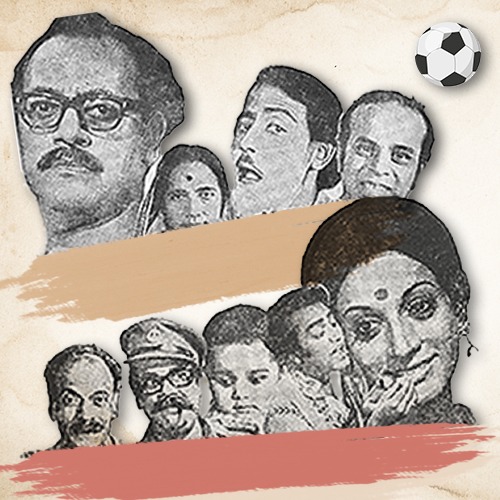
Why did the recording of Lata Mangeshkar with SD Burman and Manna Dey get cancelled on an East Bengal-Mohun Bagan match day in Mumbai? Who had dribbled in Uttam Kumar scenes from Saptapadi? Which silent film did the Great China Wall of Indian football — Gostha Pal — act in 1932?
Between keeping score of the matches played by Mohun Baganer Meye and East Bengaler Chhele, RUPAYAN BHATTACHARYA stands at the centre spot to give a first-hand feel of the madness at the Maidan
Why BFA commissioned this piece:
Even if football from Bengal has lost its past glory, the interest in the game has not waned in this part of the subcontinent. That's precisely why we requested one of our most respected journalists to archive the history of football's relationship with the silver screen. This is the first time we have come across such an analytical piece that is also richly garnished with anecdotes from the galleries
Some way off the Akashvani building, seated underneath a statue in Maidan, was actor Pradip Mukhopadhyay. Munching on peanuts with friend Goutam Chakraborty, their discussion spooled around tricky job interview questions, somewhat like the ones where one was asked the name of Ram’s sister in Ramayana!
Suddenly, a roar went up in a field. The camera cut to a one-minute-long scene on the two rupees- stand of the Mohun Bagan gallery. It captured the ecstasy of people’s celebration.
Pradip’s friend listlessly said: “Damned Mohun Bagan, a last-minute goal.”
The match had just ended at the Mohun Bagan ground with people overflowing like deluge out of the gate. Goutam caught one, who looked quite lively.
-- “Hey, brother, hey, hey, what happened there, brother?”
-- “Three to one.”
-- “So, who won?”
-- “Mohun Bagan.”
-- “Aha! Thank you.”
Then the two friends stood watching people passing by and indulged in a guessing game to understand what each did for a living. Who was unemployed? Who was a clerk? Who was a clerk on the verge of retirement? Who was a graduate?
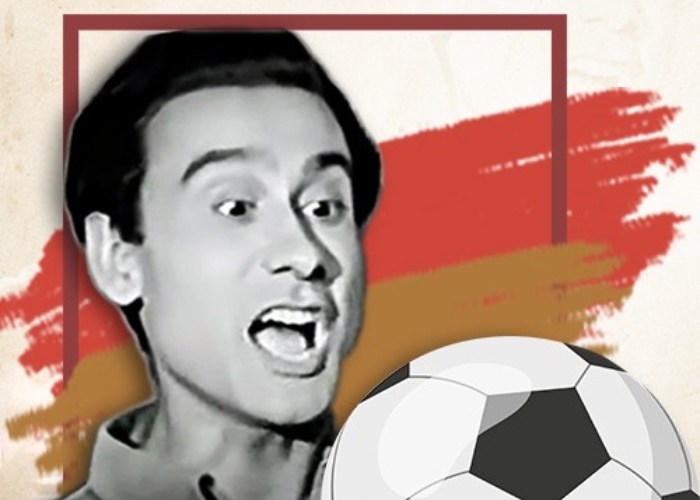
Time and again, football has found a way to becoming extremely significant in the fabric of Bengali cinema. Just like love, it had the power to evoke both smiles and sniffles. Despite the tears, people have simply loved the game.
Satyajit Ray’s Jana Aranya is a prime example of the phenomena that Kolkata football was in 1975, and just how much emotion Bengalis attached to the game.
So, what’s the most memorable Bengali film sequence involving football?
You have just one minute to answer that.
I can bet it’s one of the three-four cult scenes from Dhanyi Meye.
Perhaps, it is the one with Uttam Kumar, who, hoping for a win, prays in front of a statue of Goshtha Pal. Later, he dreams of scoring a goal and ends up kicking wife Sabitri out of the bed instead!
Or else, it is the scene when village landlord Jahar Roy starts to play referee and instructs priest Rabi Ghosh during a match, while the actual referee jumps in indignation.
Or perhaps the one where Tapen Chatterjee, Kalyan Chatterjee and others lip-sync to the cult Manna Dey song - Sab khelar sera Bangalir tumi football (Football, you are the greatest sport for us Bengalis) - in a cramped train compartment.
Or, the one where Sukhen Das does a passionate commentary while being perched on a tree.
Arabinda Mukhopadhyay’s Dhanyi Meye (1971) is unquestionably the most loved movie classic about football in Bengal. This film is so close to Bengalis that it might be hard to find someone who watched it only once. Definitively, this is the greatest Bengali film ever made on football.
But if I were to mention the greatest scene involving football, I have to choose between two in Ora Thake Odhare (1954). The director was Sukumar Dasgupta, who has given us superhits like Abhoyer Biye, Sadanander Mela, Sathihara, Haat Baralei Bandhu, Saat Number Kayedi etc. He directed a total of 18 films in his career and had a major contribution in the rise of the Uttam-Suchitra duo.
In Ora Thake Odhare, Uttam Kumar’s character is called Chanchal. He is from north Kolkata. A ghoti (the original inhabitant of the state of West Bengal) to be precise. Suchitra Sen, in contrast, plays a girl from a Bangal family (people who migrated to West Bengal from Bangladesh).
Today’s generation cannot even imagine the thrill of listening to football commentaries on the radio. Even some 50-60 years back, a huge number of people would gather round a single radio to bask in the excitement of a match being relayed on it.
This particular scene also has Chhabi Biswas and Bhanu Bandyopadhyay sitting in front of a radio. They are caught in a passionate exchange. Both on screen and off it, Chhabi Biswas and Bhanu Bandyopadhyay were fans for Mohun Bagan and East Bengal respectively. Hence the passion, derision and ecstasy portrayed in their acting came close to reactions of true-blue fans of these two rival clubs. And that is what makes this scene so memorable. Their argument runs parallel to the commentary and infuses it with a personal flavour. There’s another scene in this 1954 film featuring East Bengal supporters’ penchant for the hilsa fish. A die-heard East Bengal fan, Bhanu tells Tulsi Chakraborty that he won’t tolerate anyone belittling them for eating hilsa.
Bhanu Bandyopadhyay was a staunch regular at the East Bengal gallery. There are stories about how he would often volunteer to manage the crowd at the ground’s gate, completely disregarding his own star status... Once, a supporter was badmouthing footballer Chuni Goswami in the gallery for his poor performance. Singer Dhananjay Bhattacharya was so put off that he lobbied to get that supporter’s club membership revoked
Another memorable scene features Uttam and Suchitra along with a teenage boy and girl. They are engrossed in a conversation on a pet theme for all Bengalis — are you a East Bengal or Mohun Bagan supporter? Suchitra smiles and says: “I’ll support the team that wins.” Now, the boy supports East Bengal, but the girl supports Mohun Bagan. Inevitably, arguments ensue. Uttam appears even while Suchitra struggles to resolve their differences. The question is then directed towards Uttam. So, who does he support? Uttam first checks what Suchitra had said and then quips: “Then I’ll support the team that loses.”
Once the kids leave, Uttam says: “The weather doesn’t look so good.” When Suchitra wonders why, Uttam replies: “Why else? Today is the East Bengal-Mohun Bagan faceoff.”
There was a time when football was the heartbeat of all Bengalis. Even celebrities were not immune to this. The East Bengal-Mohun Bagan matches regularly saw attendance from the biggest names in Bengali cinema and music. Meeting them on the field was inevitable then. Even in the late 1980s actor Biplab Chattopadhyay would be frequently seen at the Mohun Bagan tent in the company of star player Subrata Bhattacharjee. Chinmay Roy was another regular later on. Interestingly, both Biplab and Chinmay, formidable and respected actors, were less famous at that time than Subrata, the player they were visiting. Yet, they would both bask in his glory.
Bhanu Bandyopadhyay was a staunch regular at the East Bengal gallery. There are stories about how he would often volunteer to manage the crowd at the ground’s gate, completely disregarding his own star status. Singer Dhananjay Bhattacharya, the most famous Bengali singer before Hemanta Mukhopadhyay, was similarly attached to the Mohun Bagan grounds. He would often walk back home to College Street after watching a match at Maidan. Once, a supporter was badmouthing footballer Chuni Goswami in the gallery for his poor performance. Dhananjay was so put off that he lobbied to get that supporter’s club membership revoked. He was a die-hard fan of Chuni and a frequent and welcome visitor to the players’ dressing room. Many players used to request him to sing before a match claiming that it inspired them.
Jahar Gangopadhyay, the screen superstar before Uttam Kumar’s arrival, even became a club official. He was the hockey secretary for Mohun Bagan for a long time. That post had a lot more importance in those days. At that time, Jahar Gangopadhyay was acting in the famous play titled Shyamali that ran at the Star Theatre. It featured Uttam Kumar and Sabitri Chattopadhyay. Barring weekends, he would come daily to have a chat at the Mohun Bagan lawn (now the location of Aryan FC tent).
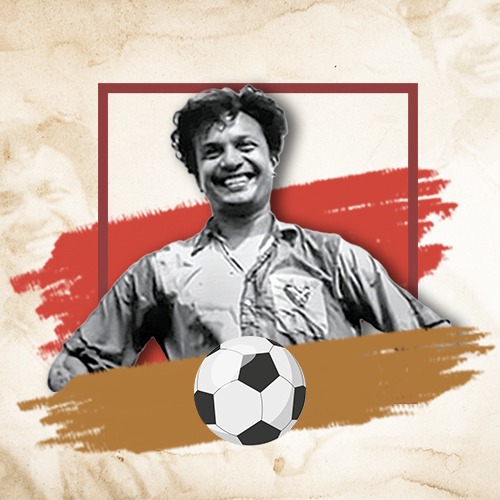
The Mohun Bagan-East Bengal rivalry had a prominent place in another legendary Bengali classic – Saptapadi (1961). Director Ajoy Kar had planned to include a football match. Back then, East Bengal and Mohun Bagan shared one ground as a joint property. Montu Bose, the owner of Basusree cinema hall and an East Bengal club official then, arranged for the East Bengal team to play the match shown in the film. Montu was the right-hand-man of East Bengal top official Jyotish Guha. East Bengal’s superstar player, Ahmed Khan, used to stay on the Basusree premises. Ahmed had a soft corner for cards and would often be seen playing a hand with Bhanu Bandyopadhyay and singer Shyamal Mitra. Even on a match day, it was supposedly often a problem to get him away from those sessions. Montu would have to plead and cajole him to go to the grounds. That’s how Bhanu would often hop on to the car that took Ahmed to the match. Just like Bhanu was a fan of Ahmed Khan, Uttam Kumar’s favourite was Chuni Goswami. He would often playfully ask brother Tarun Kumar: “Tell me who is more famous - Chuni or I?”
The Maidans have remained witness to several interesting shooting anecdotes during the making of Saptapadi. Uttam had to wear an East Bengal jersey for the film. Being the die-hard Mohun Bagan supporter that he was, he certainly did not want to do so. It was the black-and-white era in Bengali films. So, nobody would really know if the colour of the jersey was yellow-red or green-maroon. Yet Uttam would not budge. He came around finally when Suchitra personally spoke to him. East Bengal supporters often claim Suchitra was ‘theirs’— inherently partial to the team. Now, Uttam had to dribble in a muddy ground for the film. His scenes of dribbling are still discussed passionately in Bengal football. Many say the dribbling was done by Tulsidas Balaram. Others claim it was Chuni Goswami.
One can safely conclude that it was not Chuni. Mohun Bagan was then away playing in East Africa and nobody from the club was at the ground at that time. That was the main reason why Uttam did not get a Mohun Bagan jersey despite asking for it. Players were not there and at that time, it was not a common practice to store jerseys in the club. Most importantly, the whole thing was arranged by East Bengal official Montu Bose. Needless to say, he would ensure that the accent was on East Bengal.
Famous footballer Sukumar Samajpati was on the ground the day that shoot happened. He used to play for Mohun Bagan and had to drop out of the Africa trip due to an injury. Sukumar, however, believes it was neither Chuni nor Balaram who had dribbled for that scene. Memories of that day are still fresh in his mind. “I was injured then. Trying hard to stage a comeback, I was training with weighted balls. That day I went to the ground and found a huge crowd. Our gardener, Vasya, told me that both Uttam and Suchitra were present. I started running with the weighted ball as per my training schedule. Suddenly, I saw Rakhee’s husband Ajay Biswas (actress Rakhee Gulzar’s first husband) come up to me. He was requesting me to take part in the shoot. Uttam Kumar was watching us from a distance. Ajay used to be my college senior by a year. I told him: “You are a Mohun Bagan supporter. You know that I’m injured and trying to stage a comeback. It won’t be possible for me to play now.”
Then who had volunteered to dribble in the Uttam Kumar scenes? Sukumar personally believes that it was the superstar himself. Uttam Kumar was a reasonably good football player. It wouldn’t be completely outlandish for him to have performed those dribbles himself. “While I didn’t see either Chunida or Balaram on the field, many other players were there. Any of them could have done the dribbling as well,” he said.
East Bengal’s superstar player, Ahmed Khan, used to stay on the Basusree premises. Ahmed had a soft corner for cards and would often be seen playing a hand with Bhanu Bandyopadhyay and singer Shyamal Mitra... That’s how Bhanu would often hop on to the car that took Ahmed to the match. Just like Bhanu was a fan of Ahmed Khan, Uttam Kumar’s favourite was Chuni Goswami. He would often playfully ask brother Tarun Kumar: “Tell me who is more famous - Chuni or I?”
Mumbai too has seen a strong kinship between football and cinema. The Rovers Cup used to be organized in the Cooperage ground every winter. At that time, Rovers was one of the biggest tournaments in the country along with the IFA Shield and Durand Cup. Sachin and Rahul Dev Burman would regularly go to watch East Bengal play. If Mohun Bagan was playing, Manna Dey would attend. Dilip Kumar would be on the grounds if it was Mohammedan. I have personally seen Dilip Kumar attend the Rovers Cup finals as the chief guest in the 1990s.
There is a famous story involving Manna Dey at a Mumbai football match. Most East Bengal and Mohun Bagan supporters will remember this one. Back then, Manna was working as the assistant to Sachin Dev Burman. He would have to run errands and do chores for him. To reach Cooperage, they’d have to endure a long and arduous train journey to Church Gate station and then walk to the ground. Sachin Dev, whose stingy habits were well-known by then, would often buy something like a banana and then instruct Manna to pay for it. All that was done in good spirit.
If it was a Mohun Bagan-East Bengal match, SD would get Manna to sit beside him on the famous iron gallery of Cooperage. The gallery was on just one side of the ground back then. So, if Mohun Bagan scored a goal, Manna couldn’t express his joy. Let alone celebrate, he couldn’t even scream since he was seated next to SD. Extremely angry with the results, the legendary music director would cuss East Bengal players in his signature Bangal dialect and then instruct Manna to buy him some chickpeas! Throughout his life, Manna loved to recount this anecdote.
Lata Mangeshkar had once recounted to East Bengal officials a funny anecdote about Manna-SD’s rivalry regarding Mohun Bagan and East Bengal. In 1988, trying to recover from a financial crisis, East Bengal club had decided to raise money by having Lata in concert. Lata’s event manager in east India was Suprakash Gargari. He was also the football secretary of East Bengal at that time. To broach the topic, he asked if Lata had ever heard of East Bengal. Lata immediately said: “Of course, I have. Once Sachin-da was recording me and Manna-da for a song. Mumbai had an East Bengal-Mohun Bagan match that day. Sachin-da told me to wait and took Manna-da away to watch the match. I still don’t know who won that day, but I do know they had returned separately. I waited for a long time, but the recording never resumed that day.”
Back then, Mumbai film industry was ruled by a galaxy of talented Bengali singers, actors, music composers and film directors. Whenever Bengal footballers went to play the Rovers Cup, they’d be hosted at the Mumbai homes of one or the other Bengali celebrities. Many would also take residence in the hotels designated for Mohun Bagan and East Bengal in Colaba. That is where Hemanta Mukhopadhyay had once come to hear footballer Sukumar Samajpati sing.
That was in 1960. Mohun Bagan and East Bengal had to face each other for the first time in that year’s Rovers Cup semi-final. Demands for tickets were at all-time high. The Mohun Bagan team had put up at the MLA Hotel. One afternoon, Hemanta Mukhopadhyay came to pay a visit along with actor Biswajit. During those days, all the teams were given day slips to the match for distribution among special guests. Hemanta and Biswajit had come to collect some such slips. When Sailen Manna was introducing them to the team post-lunch, all of them started to plead with Hemanta to sing one of his hit songs from the Puja album. Sitting at the lunch table, Hemanta sang one of his classics - Alir katha shune bakul hase.
That’s when Chuni informed Hemanta that footballer Sukumar Samajpati was a good singer as well. Sukumar could not refuse Hemanta’s request. Ironically, he chose a composition originally sung by Manna Dey (considered to be Hemanta’s professional rival) — O amar man jamunar ange ange kotoi khela. Hemanta was very pleased with the performance and told him: “You’re a good singer. Do consider recording. Meet me after you return to Kolkata. I’ll arrange for your recording with the Gramophone company”. After quitting football, Sukumar immersed himself completely in music. But at that time, he had flatly refused. Mohun Bagan lost the match that day in a same-side goal by Jarnail Singh (Dhillon). The ball had accidentally bounced off the ponytail of one of the greatest Indian stoppers and landed inside the goalpost.
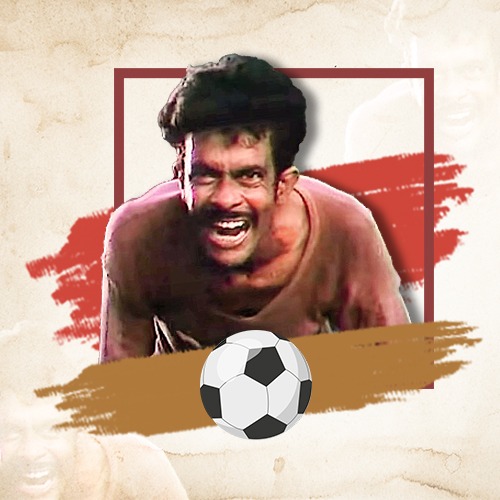
Sunil Mukhopadhyay in 'Grihajuddha'
Now, a question can arise over which other films apart from Jana Aranya, Dhanyi Meye or Ora Thake Odhare, have featured football significantly.
Two such films were released in the 1970s — Dipankar Dey-Rajashri Basu’s Mohun Baganer Meye and Samit Bhanja’s Striker. Songs from both films were big hits and would often be played in the popular radio programme, Chhayachabir Asor. Anup Ghosal’s Mohun Bagan-East Bengaler khela hoyeche was a bigger hit than Manna Dey’s Prem nagare khelte jabi chol. Striker was based on Moti Nandi’s famous novel by the same name. The premise was entirely based on football. The 1978 film featured Samit Bhanja at a time when his acting chops were on the decline. He was also much more overweight than the character demanded. Why director Archan Chakraborty chose him for the lead character is a question that still remains unanswered. Even Moti Nandi had regretted this particular casting. This regret was later mitigated though, when his swimming-centric novel, Koni, was adapted into a film and went on to become a superhit.
The 1976 film Mohun Baganer Meye directed by Manu Sen is primarily a love story. It centres around the relationship of a girl who supports Mohun Bagan with a boy who supports East Bengal. Today, this may not seem like much of a premise, but back in the 1970s this was indeed a huge deal. Interestingly, another film on this premise was made exactly 20 years later called East Bengaler Chhele starring Chiranjeet and Satabdi Roy. Chiranjeet was credited for the screenplay and dialogue writing too. It was directed by Alok Bhowmik.
Another football-centric film became a superhit when Tapas Paul was at the zenith of his career. Any film he did around that time would turn into a hit. Bijoy Bose’s Saheb (1981) featured a joint family with Utpal Dutt essaying the role of the family patriarch. Tapas played the younger son who is ridiculed and derided by other family members for his passion for wanting to become a footballer. Only his sister, Mahua Raychowdhury, and sister-in-law, Madhabi Mukhopadhyay, love and support him. The situation changes when all the older sons of the family refuse to help during a financial crisis at Tapas’ sister’s marriage. In a career-ending sacrifice, Tapas sells off a kidney to arrange for the funds, without telling anyone. The film had a popular song by Tarun Bandyopadhyay— Ekta cup, ekta shield, ekta medal ami chharbona. Two others were also big hits - Dwijen Mukhopadhyay’s Kata swapna and Manna Dey’s O mukhe shwet chandane alaka tilak enke de.
Saheb also managed a feat that is unimaginable in today’s Bengali film industry. Four years after its release, it was remade in Hindi by director Anil Ganguly. Tapas Paul’s character was played by Anil Kapoor while Madhabi’s character was played by Rakhee. Only Utpal Dutt reprised his role. Bappi Lahiri scored the music for this film. This Hindi film had the superhit song, Yaar bina chain kahan re. It got remade in Telugu as well. Titled Vijetha, the Telugu film had Chiranjeevi in the lead. The Kannada remake was called Karna and had Vishnu Vardhan as its hero. In the Malayalam remake called Chekkaeran Oru Killa, Tapas Paul’s character was played by Shankar. It will be difficult to name a contemporary Bengali film that has been remade in four major Indian languages.
Saheb also managed a feat that is unimaginable in today’s Bengali film industry. Four years after its release, it was remade in Hindi... It got remade in Telugu as well... The Kannada remake was called Karna... The Malayalam remake was called Chekkaeran Oru Killa. It will be difficult to name a contemporary Bengali film that has been remade in four major Indian languages
Arun Roy’s Egaro was made in 2011 to celebrate the centenary of Mohun Bagan’s historic IFA Shield win. Soumitra Chattopadhyay’s grandson, Ranadip, made his debut in the film and had grabbed attention. Sadly, Ranadip is now bed-ridden following a near-fatal accident.
Few years before Egaro, another football film was made in neighbouring Bangladesh called Jaago. It was directed by Khijir Hayat Khan. According to many in Bangladesh, it was one of the best sports films ever made in that country.
Some time back, actor Dev took the onus to make and star in a film on the life of Nagendranath Sarbadhikari, widely regarded as the father of Indian football. Sadly, the film took a lot of liberties with historical facts.
What about a footballer-heroine romance? One of the central plot points of Dhanyi Meye was the romance between feisty village girl Jaya Bhaduri and footballer Partha Mukhopadhyay. This is not far from the reality of Kolkata Maidan. Badru Bandyopadhyay, Mohun Bagan star and Indian captain in the Olympics, had married actress Tapati Ghosh. Long ago, footballer Anil Dey had practically lived-in with actress Anubha Gupta. Anil’s lifestyle was extremely erratic though and the relationship died out in time. This story would again return to haunt later when footballer Rajat Ghosh Dastidar broke his first marriage to tie the know with actress Sonali Choudhury.
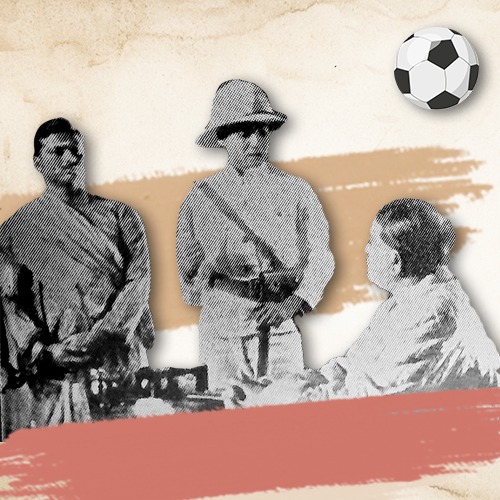
Gostha Pal, known as the ‘Great China Wall’ of Indian football, once acted in a silent film of the 1930s titled Gaurishankar
While writing on football and Bengali cinema, I am tempted to bring up some classic English films in this genre. Those films have more mystery and diversity regarding football. But the thing is, American baseball has always been more popular sport than football (or as Americans would say, soccer) in the US. So, in the earlier years, Hollywood did not make any films on football. The first English language film on football would be The Arsenal Stadium Mystery (1939). It was based on a murder incident in the Arsenal Stadium.
What is the most popular film on football globally? Most would vote in favour of Escape to Victory. Director John Hoston chose a story from WWII. Pele and Bobby Moor acted in it alongside Sylvester Stallone.
A film was made on Pele in 2016 called Pelé: Birth of a Legend. We don’t have any films on a footballer’s life like that in our country. Gostha Pal, known as the ‘Great China Wall’ of Indian football, once acted in a silent film of the 1930s (Gaurishankar). Later Umapati Kumar, Chuni Goswami, Subrata Bhattacharjee too appeared in films.
Another film in 1957 was called Garer Math (the popular name for Maidan grounds in Kolkata). Several football legends of the time like Gostha Pal, Umapati Kumar, Ahmed Khan, Bagha Som, Bhaba Roy, Padma Mitra appeared in it along with screen stalwarts like Chhabi Biswas, Anil Chattopadhyay and Sumitra Debi. The film flopped and I doubt if any print has survived.
If it was a Mohun Bagan-East Bengal match, SD would get Manna to sit beside him on the famous iron gallery of Cooperage... So, if Mohun Bagan scored a goal, Manna couldn’t express his joy. Let alone celebrate, he couldn’t even scream since he was seated next to SD. Extremely angry with the results, the legendary music director would cuss East Bengal players in his signature Bangal dialect and then instruct Manna to buy him some chickpeas!
There has been no dearth of Kolkata’s famous footballers making their screen debuts. In Chiranjeet’s East Bengaler Chhele (1996), several of them appeared as themselves. That included PK Banerjee, Subrata Bhattacharjee, Krishanu Dey, Bikash Panji, Krishnendu Roy, Amit Bhadra, Babu Mani, Atanu Bhattacharya, Debashis Mukherjee, Uttam Mukherjee, Ranjit Karmakar, Sukhen Sengupta, Debashis Sarkar. PK and Subrata’s names were given the same importance as that of Chiranjeet’s on the title card. PK, known for his public speaking skills, had some great dialogues in the film too.
I’ve already mentioned that Subrata was often seen with Tollywood celebrities. He used to perform songs at functions, styling himself in all-white like then superstar Mithun Chakraborty. He has even acted in a character role during his prime. Sadly, he himself doesn’t remember much about it now.
In 2020, he worked in Sourabh Pal’s film titled Aguner Parashmani. In this film, he plays a retired footballer who wants his son to follow in his footsteps. His son, however, fancies a career in movies. This actually mirrors Subrata’s personal life and what happened with his son, Saheb. However, this film has not yet been finished with no news on its completion schedule.
The 2010 film Jug Jug Jiyo starring Abhishek Chattopadhyay was also based on football. Subrata was cast in the role of a coach. He also worked as a technical supervisor when the actors were training in football at the Domjur stadium.
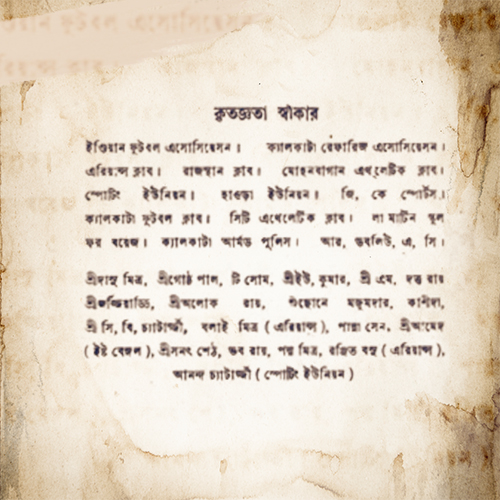
Don't miss the thanksgiving list in the credits of 'Garer Math'
After having written so much, one thing continues to haunt me. There was a time when the magic of football united the likes of Sailen Manna to Subrata Bhattacharya, Chhabi Biswas to Uttam Kumar, PK Banerjee to Chuni Goswami, Tapas Paul to Dev on screen. There was a time when both Bengali football and Bengali cinema were close to Bengalis’ hearts. Today, Bengal’s football and cinema are so much on the decline that it is impossible to imagine that a union of these two will produce magic, on screen or at the box office.
Are you a pass or honours graduate?
Today, no Bengali will answer this question with a reference to Mohun Bagan or East Bengal.
If Ray was alive today, he wouldn’t have thought of keeping such a scene. Aurobindo Mukhopadhyay too would not have conceived of a football fanatic like Uttam Kumar in Dhanyi Meye.
I suppose, one can just shut the eyes and write the above two lines.

